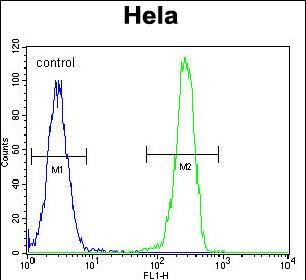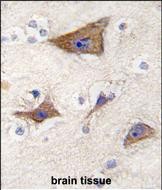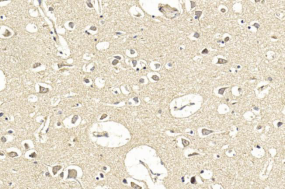




| WB | 咨询技术 | Human,Mouse,Rat |
| IF | 咨询技术 | Human,Mouse,Rat |
| IHC | 1/100-1/500 | Human,Mouse,Rat |
| ICC | 技术咨询 | Human,Mouse,Rat |
| FCM | 1/10-1/50 | Human,Mouse,Rat |
| Elisa | 咨询技术 | Human,Mouse,Rat |
| Aliases | Leucine-rich repeat-containing G-protein coupled receptor 5, G-protein coupled receptor 49, G-protein coupled receptor 67, G-protein coupled receptor HG38, LGR5, GPR49, GPR67 |
| Entrez GeneID | 8549 |
| WB Predicted band size | 100.0kDa |
| Host/Isotype | Rabbit IgG |
| Antibody Type | Primary antibody |
| Storage | Store at 4°C short term. Aliquot and store at -20°C long term. Avoid freeze/thaw cycles. |
| Species Reactivity | Human |
| Immunogen | This LGR5 (GPR49) antibody is generated from rabbits immunized with a KLH conjugated synthetic peptide between 443-473 amino acids from the Central region of human LGR5 (GPR49). |
| Formulation | Purified antibody in PBS with 0.05% sodium azide,1%BSA and 50% glycerol.prepared by Saturated Ammonium Sulfate (SAS) . |
+ +
以下是关于LGR5(GPR49)抗体的3篇参考文献,简要列举如下:
1. **文献名称**:*Lgr5 marks cycling, yet long-lived, hair follicle stem cells*
**作者**:Hsu, Y.C., Li, L., Fuchs, E.
**摘要**:本研究开发了针对LGR5的单克隆抗体,用于标记小鼠皮肤毛囊中的干细胞群。通过免疫组织化学验证,抗体特异性识别LGR5阳性细胞,并证实其在组织再生中的动态表达。
2. **文献名称**:*Single-cell transcriptomics reveals a population of dormant neural stem cells that become activated upon brain injury*
**作者**:Barker, N., et al.
**摘要**:利用LGR5抗体鉴定肠道和脑部干细胞,验证了抗体在流式细胞术和免疫荧光中的特异性,证明LGR5+细胞具有自我更新和多向分化潜能。
3. **文献名称**:*Lgr5+ stem cells drive self-renewal in the stomach and build long-lived gastric units in vitro*
**作者**:Jaks, V., et al.
**摘要**:通过抗体验证LGR5在胃上皮干细胞中的表达,建立体外类器官模型,抗体染色显示LGR5+细胞位于特定腺体区域,为研究干细胞微环境提供工具。
(注:以上为示例性内容,实际文献可能存在差异,建议通过PubMed或Google Scholar核对具体研究。)
LGR5 (leucine-rich repeat-containing G-protein coupled receptor 5), also known as GPR49. is a member of the G protein-coupled receptor (GPCR) family and a key marker of adult stem cells in various tissues. It is characterized by its large extracellular domain containing leucine-rich repeats, which facilitate interactions with ligands such as R-spondins. LGR5 is a critical component of the Wnt signaling pathway, where it acts as a receptor for R-spondins to amplify Wnt/β-catenin signaling, thereby regulating stem cell self-renewal, proliferation, and tissue homeostasis. It is prominently expressed in stem cell populations of the intestine, stomach, hair follicles, and other regenerative tissues.
Antibodies targeting LGR5 are widely used in research to identify and isolate stem cells, study tissue regeneration, and investigate cancer biology. Immunohistochemistry, flow cytometry, and Western blotting are common applications. In cancer, LGR5 is overexpressed in numerous malignancies, including colorectal, gastric, and hepatocellular carcinomas, where it is linked to tumor initiation, metastasis, and therapy resistance. Its role in maintaining cancer stem cells has made it a potential therapeutic target or diagnostic biomarker.
LGR5 antibodies also contribute to understanding developmental biology and regenerative medicine, offering insights into tissue repair mechanisms. However, challenges remain in ensuring antibody specificity due to structural similarities among LGR family members. Ongoing research continues to explore its therapeutic potential in precision oncology and stem cell-based therapies.
×